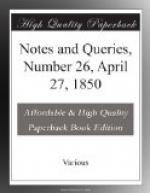“Boys and girls, come out to play;
The moon doth shine as bright as day;
Come with a whoop, come with a call,
Come with a good will, or come not at
all.” {423}
“Garcons et filles, venez toujours;
La lune fait clarte comme le jour;
Venez au bruit d’un joyeux eclat;
Venez de bon coeur, ou ne venez pas.”
W.(1.)
St. Antholin’s Parish Books.—In common with many of your antiquarian readers, I look forward with great pleasure to the selection from the entries in the St. Antholin’s Parish Books, which are kindly promised by their present guardian, and, I may add, intelligent expositor, “W.C.”
St. Antholin’s is, on several accounts, one of the most interesting of our London churches; it was here, Strype tells us (Annals, I. i. p. 199.), “the new morning prayer,” i.e., according to the new reformed service-book, first began in September, 1559, the bell beginning to ring at five, when a psalm was sung after the Geneva fashion, all the congregation, men, women, and boys, singing together. It is much to be regretted that these registers do not extend so far back as this year, as we might have found in them entries of interest to the Church historian; but as “W.C.” tells us the volumes are kept regularly up to the year 1708, I cannot but hope he may be able to produce some notices of what Mr. P. Cunningham calls, “the Puritanical fervour” of this little parish. “St. Antling’s bell,” and “St. Antling’s preachers,” were proverbial for shrillness and prolixity, and the name is a familiar one to the students of our old dramatists. Let “W.C.” bear in mind, that the chaplains of the Commissioners of the Church of Scotland, with Alexander Henderson at their head, preached here in 1640, commanding crowded audiences, and that a passage was formed from the house where they lodged into a gallery of this church; and that the pulpit of St. Antholin’s seems, for many years, to have been the focus of schism, faction, and sedition, and he may be able to bring forward from these happily preserved registers much interesting and valuable information.
D.S.
* * * * *
MISCELLANEOUS.
NOTES ON BOOKS, CATALOGUES, SALES, &C.
No one can have visited Edinburgh, and gazed upon
“The height
Where the huge Castle holds its state,”
without having felt a strong desire to learn the history of that venerable pile, and the stirring tales which its grey walls could tell. What so many must have wished done, has at length been accomplished by Mr. James Grant, the biographer of Kirkaldy of Grange, the gallant governor of that castle, who was so treacherously executed by the Regent Morton. His work, just published under the title of Memorials of the Castle of Edinburgh, contains its varied history, ably and pleasantly narrated, and intermixed with so much illustrative anecdote as to render it an indispensable companion to all who may hereafter visit one of the most interesting, as well as most remarkable monuments of the metropolis of Scotland.




